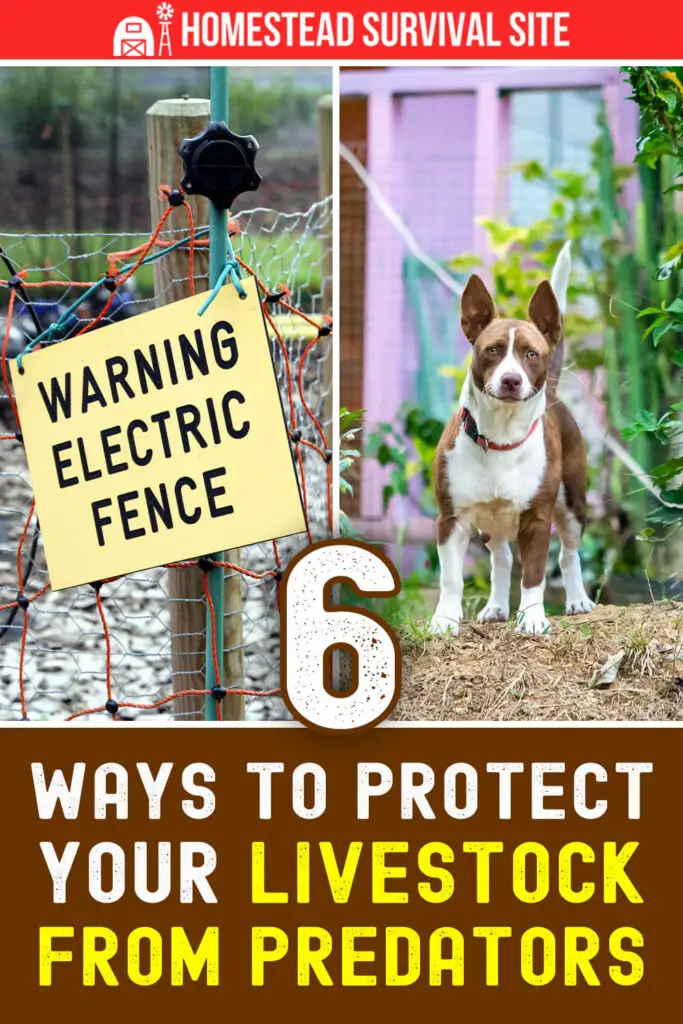Estimated reading time: 8 minutes
Whether you keep poultry, cows, sheep, goats or other types of livestock, there are predators that will try to make a meal out of your animals, and there are common principles and methods you can use to protect your livestock from said predators. Here are a few of the most effective ones.
The first three items on our list are types of fences. Creating a fence to keep predators out is generally more expensive than creating one to keep livestock in, so fencing large areas against predators may not be your best option.
Instead, it is usually best to pen animals in, bringing your livestock back from pasture at night into a smaller, predator-proof fenced-in area, or into the shelter of a barn, coop, or other building. Using lights to light the area will also decrease predator activity.
As a side note, when protecting poultry from predators, no simple fence will work, since some of their predators fly (e.g. hawks and eagles), or can easily climb or dig under fences.
Want to save this post for later? Click Here to Pin It on Pinterest!
1. Built Fences
These are fairly self-explanatory and there is a great deal of information online with various fence designs, but again, to construct a predator-proof fence is much more costly than a livestock fence. Larger predator-proof fences should be at least 6 feet and even up to 8 feet high, with spaces no more than 6 inches large to prevent predators from being able to squeeze through.
Some farmers have reported that even this isn’t enough as coyotes have been known to climb fences up to 6 feet or more, and so one method is to add a “hot wire” or electric wire to the top of fences in case they get that far. Additionally, a woven-wire apron, 24 inches or wider, should be attached to the outside of the fence with hog rings to prevent predators from digging under.
Smaller predators of poultry will definitely be able to easily get through most types of fences by climbing, squeezing through, or digging, so again, bringing them in at night is the standard way of dealing with poultry predators. Shelters should be secured with hardware cloth anywhere where there is even a small hole, as weasels and the like can squeeze through very small openings, or reach through to grab your birds.
2. Electric Fences
Electric fences have been in use for more than two decades, and they can be useful for deterring predators ranging from coyotes, wolves, and mountain lions, to domestic dogs. They may also be useful for controlling smaller predators such as foxes, raccoons, or weasels if baited with appropriate food to attract a given animal.
A 1970s study by the government of Alberta concluded that losses of sheep from predation can be reduced by 90 percent with electric fencing. Done well, one might be able to achieve even better results, particularly if baiting practices are used.
The benefit of electric fences is that they are relatively cheap compared to built fences, and nearly instant. They can be electrified via solar power as well, so they need not be close to a power source. They do, however, require regular inspection and maintenance, and may not be as effective in the winter for controlling predators. Electric fences can be either multi-strand, single strand, or mesh wire designs, but mesh wire offers a better barrier and requires less maintenance.
One effective design is a 9-wire fence of 12.5 gauge wire at a height of 5 feet, with the bottom wire being charged (positive), alternating to the next wire up being grounded (negative), and so on upward. If predator pressure is low, a 7-wire fence may also be possible, but if pressure is high, an 11-wire design may be appropriate, with a 5 to 6-foot fence height. The 11-wire design may also be necessary if bears are an issue.
An effective mesh wire fence is made with galvanized mesh wire with spacing of 6 inches apart or less at the bottom, with the possibility of increasing spacing for the top 20 inches or so.
Existing barbed wire fences may also be electrified, provided that they’re in good condition, without rust. Again, keep in mind that predators may get through if spaces are larger than 6 inches.
Finally, to ensure that an electric fence is effective, it is important to note that a predator must be close to a ground rod when shocked, so you should ground non-charged wires to grounding rods at intervals of no more than 10 feet along the fence.
A fence should also maintain between 4,000 and 5,000 volts for a shock to be sufficient for deterring wolves and coyotes, and to really increase effectiveness, you may choose to bait fence with meat so that predators will get a good shock on the mouth and will then be hesitant to go near the fence again, even in the winter when the fence may be less effective.
Some farmers also believe wolves and coyotes will prevent others in their pack from going near a fence once shocked, and for this reason, it is ideal to keep the same wolves and coyotes around (don’t kill them, or a new, untrained pack will simply come in!).
3. Living Fences
Although not traditionally used for protecting livestock, living fences (or hedgerows) deserve a mention because they can be useful for protecting against predators by simply allowing you to keep your animals close to your homestead to be protected by guardian animals (see below) and potentially bringing them in to shelter at night.
They may even be able to be designed to create barriers for wolves, coyotes, and other predators, but this is not something this author has experience with, and there is very little information online about this.
A living fence is simply a tight, wide hedge, often using thorny, impossible-to-penetrate species of trees and shrubs. This underutilized type of fencing is popular in many parts of the world, but despite its many advantages, it isn’t well-known in North America. It is probably the cheapest type of fence you can create, as well as the longest lasting, while also providing many ecological benefits for livestock and the farm in general.
Although living fences may take longer to create than other types of fences, once established, they may last hundreds of years with little maintenance other than an occasional trim, depending on the species. A good strategy might be to use electric fencing until a living fence is established along your fence line, or to plant a living fence along an existing wood or wire fence to replace it in time.
Since the costs of a living fence can be as little as the cost of seed (cheap or free), you can also fence larger areas on a tighter budget if you plan well ahead. Species of tree and shrub to consider for keeping your animals enclosed include very densely planted honey locust, osage orange, black locust, hawthorns, and blackthorn.
4. Shelters
This is a rather obvious consideration for protecting your livestock, and it is often needed not just for predator protection, but for protection from the elements as well.
There are many good shelter designs for various livestock online, but the important thing to consider is the predator you are protecting from, and with this in mind, to ensure that digging animals cannot dig under walls (either making a contained floor, or using measures to prevent digging such as an apron), and ensuring there are no openings large enough for the predator to get in.
5. Guardian Animals
Guardian animals include llamas, donkeys, mules, ponies, and guardian dogs. If coyotes or domestic dogs are the issue, donkeys, llamas, or a couple of dogs may be good enough to protect your livestock, but if wolves or larger predators are an issue, guardians may not work, or you may need many dogs and other guardians. In this case, keeping livestock enclosed in predator-proof pens or shelters at night may be the ticket.
The benefit of using donkeys, mules, ponies or llamas is that they live longer than dogs, and can get a good portion of their feed directly from the land via pasture and forage.
6. Good Husbandry
Although we already went over husbandry methods of bringing animals in at night, and keeping them close to the homestead, it is worth mentioning that young animals are particularly vulnerable to predation, so for this reason, you should keep young ones and their mothers near your home at all times ideally, protected with a predator-proof fence if possible.
For poultry, if you aren’t able to commit to locking them in every night, consider training them to come in on their own and use an automatic door that will close at night and open again during the day.
Let the above strategies for protecting your livestock from predators be the start of your journey towards becoming an expert at keeping your livestock safe from harm, and know too that occasionally, you may lose an animal, and that this is just part of life on a farm or homestead.
Learn from your mistakes, continue to expand your knowledge, and in time the number of animals you lose can be dramatically reduced, or even completely eliminated. If you have any of your own tips or tricks for protecting livestock, or have any comments on the above methods, please feel free to share below!
Like this post? Don't forget to Pin It on Pinterest!












Per #5 Guardian Animals, roosters can provide some protection for a flock of chickens, but roosters are not an ultimate protector.
Good roosters (and there are some lazy/selfish ones) will be vigilant and warn the hens of danger. I just saw a good demonstration of that this weekend when my rooster alerted the flock to a hawk flying nearby. They all ran inside the run.
As a defender, they’re limited. A rooster cannot, for example, take on a coyote and win. I lost a rooster to a fox attack a couple years ago. He gave his life to save his hens, but at the end of the day, he was only a trail of feathers.
Per #6, Chickens will tend to put themselves away at dusk. Not much training required. They instinctively try to return to the same place every night to sleep. A predator-proof coop and run are important. Opening and closing the run door each day isn’t all that demanding to be automated.
The use of random-blinking lights has helped us a lot in protecting from coyotes but only in a relatively small field. Same for various noise makers including a radio playing near the fence line.
I rarely see the use of the grey goose as a protector. while it doesn’t have too much in the way of defenses it does have good eyesight and hearing. it knows who belongs and who doesn’t. its alarm is loud and unmistakable. it is also intimidating to any human. its bite is very painful from the teeth-like protrusions on the bill. It also lives long and its food comes from grazing and whatever scraps from the table. warning !! it doesn’t get along with children very well and can harm small ones. they are not prone to disease and will integrate with chickens. other animals tolerate them well but dogs depending upon the breed can cause unneeded alarms.———- I, Grampa